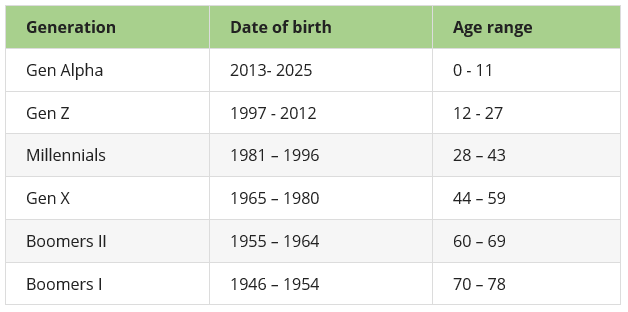Engaging consumers in research has always been a challenge for insight experts, and this challenge becomes even more difficult with research projects that run for a significant amount of time. It’s no secret that different generations of consumers are engaged in different ways. What interests a Boomer will be vastly different to a Gen-Z, and you need to know your audience intimately if you want to engage them in any sort of market research. Who are they? What are their values? What type of communication or activities do they prefer?
You may have an online community with multiple generations of members inside it. This is great for gathering diverse perspectives and experiences, but equally, it can be hard to create content that is engaging for all. Having a selection of activities for members to participate in is a good way to begin, as well as understanding what works well for each generation.

The typical generation markers can be found in the table above. Of course, these aren’t set in stone and you may find crossovers between generations that are close to each other. Understanding these markers and which behavioural characteristics go along with each one is a great starting point for any engagement strategy.
Younger Generations: Gen Z / Millennials
Millennials grew up in an exciting time with lots of developments. They had some access to the internet and likely had dial-up internet that always cut off when someone rang the house phone...yes house phones as not everyone had mobiles. They probably also remember their first mobile being a Nokia or similar, where they had to purchase ringtones and play Snake! Whereas, Gen Z grew up with the internet and streaming services. Their first phone was probably a smartphone. They are tech-savvy, aware of their digital footprint and spend a lot of their time online.
Both these groups have grown up with the internet, and so are more aware of the risks inside the digital world. They are more conscious of online privacy compared to other generations. This can lead them to be more reserved with what they put out there into the digital world for all to see. So, with all of this in mind, here are some engagement tactics that could help engage these demographics:
1. Use forums wisely
Forum discussions on controversial topics may put these generations of participating over a fear of being cancelled or future repercussions when they head into a workplace or of being called out online by others. We hear of so many stories of people getting famous and a tweet from 10 years ago coming back to haunt them. So, it's understandable why Gen-Z may be a little more reserved in open forum discussions, especially if their name is linked to the comments.
2. They value privacy - even when social
Following the on from this theme, it’s been noted that younger generations are also moving towards more private social networking platforms. Platforms such as Discord and Bereal are popular. On platforms such as Instagram, Gen-Z are posting less when we compare them to millennials. Some accounts may have plenty of followers but have posted no public images on display. Showing they may be less inclined to share online. With this in mind, activities where members cannot see others' responses such as surveys, question boards and polls may be preferred.
3. Gain their trust early on
This demographic prefers texting to phone calls. If your community has lots of video activities or video responses in surveys, especially early on before trust has been earned you may find you lose a lot of this age group. If you want video activities or interviews, it would be good to incentivise these to encourage participation. Ensuring it’s clear that the videos won’t be shared online so they feel more comfortable too.
4. Engage shorter attention spans
It’s best to avoid long newsletters, as they won't sit and read lengthy text. They prefer to mindless scroll as their attention span is low. Instead keep newsletters/emails short and sweet, I would recommend a one-page maximum. Have clear points of action with buttons to link to your activities. If relevant to your brand use gifts and memes to grab attention, also a good email caption will help increase your open rates. This generation gets a lot of emails, and many go unread, so you need to stand out to be in for a chance.
They love experiences! To generate organic and genuine engagement and interaction try to make your community a place to hang out. Although, it won’t work if this feels forced and unauthentic to your brand. It can be tricky to get this right but if you want them to come back time and time again, make the community entertaining.
Older Generations: Gen X/Boomers
Boomers are an affluent group and have the most purchasing power. They are doing well economically so don’t forget about them when marketing products. This generation is likely to also have a bit more spare time on their hands, this can be good if you can engage them in your online community as they have the potential to be good core members. Some may see market research as a hobby. They enjoy shaping brands and seeing their feedback being used, so be sure to send regular (quarterly) updates as to how what they’ve participated in has made a change internally.
There are a few key things that we should keep in mind:
1. Use clear instructions
Have clear instructions – Gen X and Boomers have not grown up with the internet, so ensure your activities are clear with information in places that make sense. While they may not be as confident with using technology compared to other generations, they’ve still embraced it and use it daily - but they like to feel in control. If your site/community is too complex or if too many technical issues keep arising you could lose them for good. Some may not have the patience to persist so if they feel it's not worth investing time into getting their head around your platform you may struggle to get insights from this generation. It’s useful if you can provide a phone number so they can call if you’re running a focus group or online interview in case, they have issues joining.
2. Create engaging newsletters
Long-form newsletters can be a good way to engage boomers. They perhaps have a bit more time on their hands, especially if retired. They may be a part of your community as a hobby or even as a loyal customer wanting to give their views. So, a slightly longer newsletter can work well as long if members feel like it’s giving value/insight. You could provide monthly updates on what research has been happening, or how it has made a difference internally.
You could also include a member spotlight to showcase the community/social element of your platform if you have spaces where members can chat. This could encourage members to start organic forum discussions themselves about topics that matter to them. You never know what insights may come up from these activities. When writing newsletters, it’s crucial to avoid hashtags, slang and gifs within these newsletters as it will set the wrong tone and you may notice your open rates drop in future communications.
3. The power of sharing
Forum discussions based on knowledge sharing and experiences are likely to work well. Boomers have life experience, so tap into that. Get them talking and sharing. Ensure you have moderators in your spaces where members communicate, to cultivate an environment where members feel safe to share personal experiences. It’s also important they feel listened to, so having a moderator who interacts and asks good questions to further the conversation is key to getting the most out of forum discussions.
One to Watch: Gen Alpha
Lastly, Generation Alpha is the one to watch. They are still a bit young to be participating in market research on their own, but are currently starting to influence consumer buying trends and are carving out a distinct set of behavioural patterns and opinions. So, following and building an understanding of them now is important. Anything brands can do to boost brand awareness and loyalty with Gen Alpha will likely pay off in the future.
We are gathering a lot of interesting intelligence about Gen Alpha so far through their interactions with brands and online social presence; so far, we've learnt that:
- They are increasingly mature. They prefer to shop at the same places as their parents. Top Christmas gifts for this age group included Stanley cups, Sephora makeup and even skincare, Dyson air wraps, iPhone and more. These are all gifts an adult would also love to receive. This highlights that Gen Alpha wants to be treated maturely.
- While the majority of Gen Alpha are not of working age yet, they do have significant purchasing power. Being tech-savvy, they can sway their parents into purchasing items quite easily. Pair this with the point above of Gen Alpha leaning towards purchases that parents would also enjoy, they know the right things to say to get mum/dad to buy it for them.
When they begin to hit market research age, you want to be ahead of the curve and know how to engage them in your community, this will allow us to better understand what incentives and tactics we can use to engage them in market research alongside the other generations. This way, insight teams can help brands stay ahead of the competition and implement truly impactful strategies from the get-go.


















